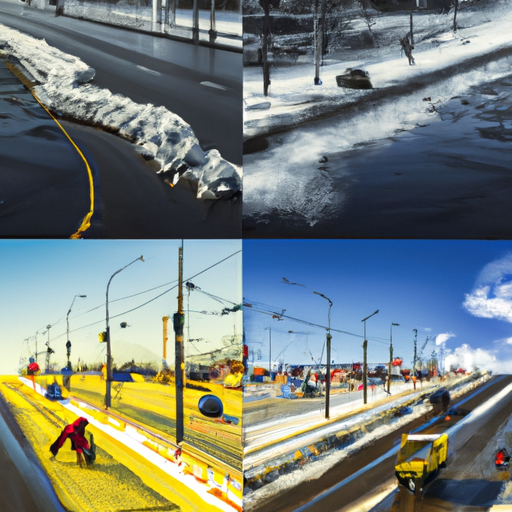Discover the ins and outs of effective road cleaning in our comprehensive guide. Discover 10 expert tips that you absolutely need to know to make your roads sparkle. From selecting the right cleaning tools to understanding the role of weather conditions and time of day, our guide covers it all. Don't miss out on these industry secrets that will elevate your road cleaning game.
1. Choosing the Right Tools: How Important Is It?
When it comes to road cleaning, choosing the right tools is of utmost importance. The tools you use can greatly impact the efficiency and effectiveness of the cleaning process. It's not just about having any tool, but about having the right tool for the job.
First, consider the type of road surface you are cleaning. Different surfaces require different tools. For example, a broom or brush may be suitable for cleaning a paved road, while a high-pressure water jet may be more effective for removing debris from a gravel road. Using the wrong tool can not only result in ineffective cleaning, but it can also cause damage to the road surface.
Secondly, consider the size and type of debris you are dealing with. If you need to clean large debris such as tree branches or rocks, you may need heavy-duty equipment like a road sweeper or a vacuum truck. On the other hand, if you are dealing with smaller debris like leaves or dust, a leaf blower or a street sweeper may be more appropriate.
Additionally, the quality of the tools you choose can make a big difference. Investing in high-quality tools may initially seem more expensive, but they are likely to be more durable and efficient in the long run. Cheap and low-quality tools may break easily or not perform as well, leading to frequent replacements and increased costs.
Finally, don't forget about safety. Choosing tools that are ergonomically designed and easy to handle can reduce the risk of accidents and injuries. Look for features like comfortable grips, adjustable handles, and safety guards.
1. A wide range of road cleaning tools showcased with labels
2. 'The Early Bird Gets the Cleanest Roads': Timing in Road Cleaning
Timing is a crucial factor when it comes to road cleaning. As the saying goes, 'the early bird gets the cleanest roads.' Cleaning roads at the right time can make a significant difference in the effectiveness of the cleaning process.
First, consider the traffic flow. Cleaning roads during off-peak hours, such as early morning or late at night, can minimize disruptions to traffic and ensure smoother operations. It allows the cleaning crew to work more efficiently without having to navigate through heavy traffic, resulting in a faster and more thorough cleaning process.
Secondly, pay attention to weather conditions. Cleaning roads after a rainfall can be more effective as the water helps to loosen dirt and debris, making them easier to remove. However, avoid cleaning roads during heavy rain or storms, as it can be dangerous for the cleaning crew and may lead to further road damage.
Additionally, consider the specific needs of the road. Some roads may require more frequent cleaning due to factors like high traffic volume, construction activities, or nearby industrial areas. By understanding the specific demands of each road, you can schedule cleaning activities accordingly to maintain cleanliness and safety.
3. Weather Conditions and Road Cleaning: Should You Care?
Weather conditions are a crucial factor to consider when it comes to road cleaning. While it may seem like an obvious consideration, it is often underestimated. However, understanding the impact of weather on road cleaning can greatly enhance the efficiency and effectiveness of the cleaning process.
Firstly, different weather conditions can affect the accumulation and composition of debris on the roads. For example, during dry and windy weather, dust and loose particles tend to accumulate, making the roads dirtier. In contrast, rainy weather can wash away some of the debris, but it can also create mud and slippery surfaces. By being aware of these weather-related factors, road cleaning efforts can be tailored accordingly.
Secondly, extreme weather conditions, such as heavy rain or snowstorms, can significantly hinder road cleaning operations. It is essential to prioritize the safety of the cleaning crew and avoid conducting cleaning activities during hazardous weather events. Additionally, extreme weather can also cause road damage, such as potholes or cracks, which may require specialized cleaning techniques or repairs.
Finally, weather conditions can impact the drying time of cleaning agents and solutions used during the road cleaning process. For example, if the weather is excessively hot and dry, the cleaning solutions may evaporate quickly, reducing their effectiveness. On the other hand, in cold weather, the drying process may take longer, causing potential inconvenience to motorists.
3. A photo collage depicting different weather conditions and their impact on road cleaning
4. Techniques and Strategies: Are You Cleaning Your Roads Effectively?
When it comes to road cleaning, employing the right techniques and strategies is crucial to ensure effective results. Simply sweeping or hosing down the roads may not be enough to thoroughly clean them. Here are some key techniques and strategies to consider:
- 1. Mechanical Sweeping:
Utilizing mechanical sweepers with rotating brushes can effectively remove larger debris, such as leaves, gravel, and trash. These sweepers can reach into corners and crevices, ensuring a more thorough clean. - 2. High-Pressure Washing:
For stubborn stains, oil spills, or heavily soiled areas, high-pressure washing can be highly effective. This technique involves using water at high pressure to dislodge and remove dirt and grime. It is particularly useful for cleaning sidewalks, parking lots, and other heavily trafficked areas. - 3. Vacuuming:
Vacuuming is an excellent technique for removing finer debris, such as dust, dirt, and small particles. Industrial vacuum cleaners equipped with filters can efficiently collect these particles without dispersing them back into the air. - 4. Chemical Treatments:
In some cases, chemical treatments may be necessary for effective road cleaning. These treatments can include the use of environmentally friendly detergents or solvents to dissolve and remove stubborn stains or residue. It is important to ensure that the chemicals used are safe for both the cleaning crew and the environment.
10 Expert Tips for Road Cleaning:
| Tip Number | Tip | Description | Example |
|---|---|---|---|
| 1 | Choose the right cleaning tools | Select cleaning tools that are appropriate for the job, and are designed for use on roads. | Pressure washers, squeegees, and mops. |
| 2 | Understand the role of weather conditions | Certain weather conditions can affect the effectiveness of cleaning. | Extreme temperatures can damage some materials. |
| 3 | Time of day matters | Cleaning should be done at the appropriate time of day to ensure optimal results. | Cleaning should be done early in the morning or in the evening to avoid direct sunlight. |
| 4 | Be aware of traffic patterns | Be aware of the traffic patterns on the roads you are cleaning to ensure safety and optimal results. | Avoid cleaning near busy intersections and areas where traffic is heavy. |
Road cleaning is a significant aspect of maintaining our urban environments, and with the expert tips provided in this guide, you are now well-equipped to tackle this task. Remember, it's not just about having the right tools, but also about understanding the factors that influence the cleaning process. Keep learning, keep experimenting, and keep our roads clean.



